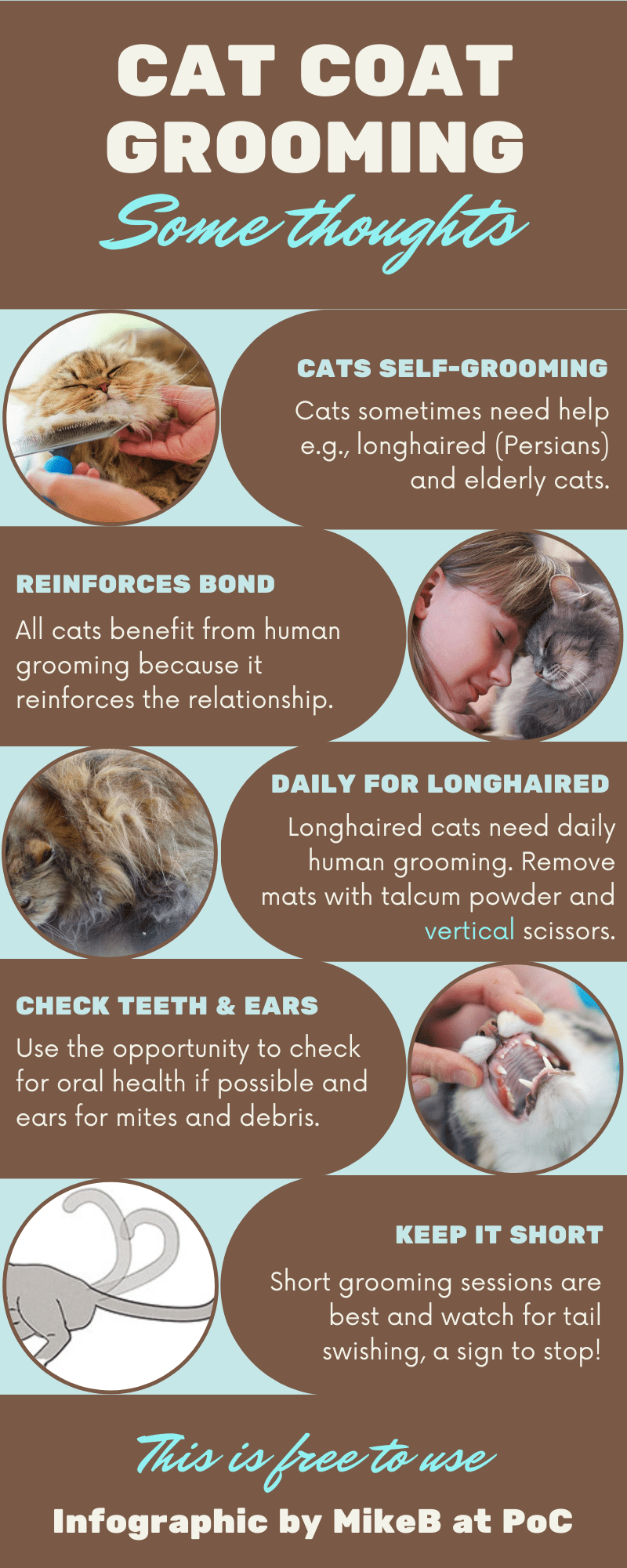Here are some brief notes in the form of an infographic on human intervention in helping their cat to maintain a good and healthy coat. In terms of hygiene and keeping the coat in excellent condition, human intervention is only normally needed for semi-longhaired and longhaired cats (mainly the latter). Through selective breeding, the contemporary Persians have extraordinarily long coats which are beyond the means of the cat underneath to keep it in good order 😢. This is really about Persians. No random bred cat has fur as long.

But as mentioned in the infographic there is a real benefit to the human-to-cat relationship in grooming a shorthaired cat particularly with a flea comb which is feasible despite the tight teeth. The benefit is bonding. Cats love the feeling of the comb against their skin and you can tackle those spots they can’t reach for extra pleasure.
A semi-longhaired cat needs twice-weekly human grooming with a bristle or slicker brush followed by combing the long hair with wide-toothed comb. Getting rid of matts on longhaired cats should be done with great care and as mentioned in the infographic with vertical (the skin) scissors and a comb between scissors and skin.
As for self-grooming, a typical domestic cat spends about 10% of their awake time grooming themselves. Fastidiousness comes to mind and it is why humans don’t need to wash or bathe their cat unless for a rare specific reason. Perhaps cat caregivers should consider working harder and longer on their personal hygiene 😉.
Cats groom themselves in a sequence which is always the same. Grooming cleans the skin and spreads the cat’s scent over their coat. If they have fleas this is the time when they can ingest one and acquire a tapeworm infection as the flea is part of the tapeworm lifecycle.
Cat grooming also deposits saliva on the fur where is forms part of cat dander which dries and flies off landing on furniture. It contains Fel D1 the cat allergen.
Dr Fogle says that he is pleased when a cat owner regularly grooms their cat as they are easier to handle in the consulting room!
Other caregiving that can be undertaken at the time of coat maintenance are:
- checking oral health (very tricky but important)
- checking ears
- checking claws if cat is elderly to trim them if ingrowing.
- checking the eyes and area below the eye for tear duct overflow (Persians mainly). Angels Eyes is a solution that can remove the staining.
RELATED: My cat has matted fur. How do I go about grooming matted cat fur?

The mantra with trimming claws is to do it when the adult was a kitten and recently adopted. Same as above. They get used it and there is little problem. It pays to check the forepaws of older cats regular to watch out for ingrowing claws and trim them before the claws turn into the paw pad. That makes it more painful for the cat (and for the person emotionally!) to trim.

